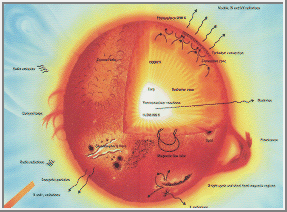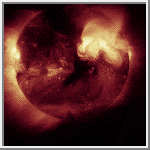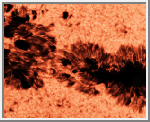 The Sun
The Sun
Mankind will not remain on Earth forever, but in its quest for light and space will at first timidly penetrate beyond the confines of the
atmosphere, and later will conquer for itself all the space near the Sun. -- Konstantin E. Tsiolkovsky

Solar Resources On The World-Wide Web

Introduction
The Sun is largest, most prominent object in our Solar System and contains approximately 99% of the total Solar System mass. One hundred and nine Earths could fit across the Sun's disk, and its interior could hold over 1.3 million Earths. The Sun's outer visible layer is called the photosphere and has a temperature of 6,000 °C (11,000 °F). This layer has a mottled appearance due to the turbulent eruptions of energy at the surface.
Solar energy is created deep within the core of the Sun. Here the temperature (15,000,000 °C, or 27,000,000 °F) and pressure (340 billion times Earth's atmospheric pressure) is so intense that nuclear reactions can take place. The main reaction is called the proton-proton cycle, as it fuses four protons (hydrogen nuclei) into an alpha particle (a helium nucleus). The alpha particle is about 0.7 percent less massive than the four protons, so the difference in mass has to appear as energy, mostly in the form of photons. Every second 700 million tons of hydrogen are converted into helium "ashes". In the process, 5 million tons of matter are converted into heat energy.

Sun Diagram (Courtesy NASA/ESA)
(Click image for an enlarged view.)The corona is the outer part of the Sun's atmosphere. In this region prominences appear, which are immense clouds of glowing gas that erupt from the lower corona. The outer region of the corona stretches far into space and consists of particles slowly escaping from the Sun. The corona can only be seen during total solar eclipses.
The Sun has been active for 4.6 billion years and has enough fuel to go on for another five billion years. At the end of its life, the Sun will start to fuse helium into heavier elements and its outer atmosphere will swell, ultimately growing so large that it will probably swallow the Earth. A star in this stage is called a red giant. After half a billion years as a red giant, the Sun will collapse into a white dwarf -- the final end product of a star like ours. A white dwarf is white-hot, and roughly only twice the size of the Earth. Every teaspoon of it weighs a thousand pounds. It may take a trillion years to cool off completely.

Sun Statistics
Mass ........................................... 1.989 X 1030 kg Mass (Earth = 1) .................................... 332,830 Equatorial radius ............................... 695,000,000 meters Equatorial radius (Earth = 1) ........................ 108.97 Mean density ........................................... 1.41 gm/cm3 Rotational period ..................................... 25-36 days* Escape velocity ..................................... 618,020 m/s Luminosity ..................................... 3.827 X 1026 J/s Mean surface temperature ...............................5,780 °C Age ............... ..................................... 4.7 billion years Principal chemistry (by number of atoms) Hydrogen ....................................... 92.1 % Helium .......................................... 7.8 % Oxygen .......................................... 0.061 % Carbon .......................................... 0.030 % Nitrogen ........................................ 0.0084% Neon ............................................ 0.0076% Iron ............................................ 0.0037% Silicon ......................................... 0.0031% Magnesium ....................................... 0.0024% Sulfur .......................................... 0.0015% All others ...................................... 0.0015%* Because the Sun is liquid, its period of rotation at the surface varies from approximately 25 days at the equator to 36 days at the poles. Deep down, below the convective zone, everything rotates with a period of 27 days.

Views of the Sun
 Sun Prominence
Sun Prominence
This image was acquired from NASA's Skylab space station on December 19, 1973. It shows one of the most spectacular solar flares ever recorded, being propelled from the Sun by magnetic forces. It spanned more than 588,000 km (365,000 miles) of the solar surface. In this photograph, the solar poles are distinguished by a relative absence of supergranulation network, and a much darker tone than the central portions of the disk.
 X-Ray Image of Sun
X-Ray Image of Sun
This is an x-ray image of the Sun obtained on February 21, 1994. The brighter regions are sources of increased x-ray emissions. (Courtesy Calvin J. Hamilton)
 Sun Spots
Sun Spots
This image shows the region around a sunspot. Notice the mottled appearance. This granulation is the result of turbulent eruptions
of energy at the surface. (Courtesy National Solar Observatory/Sacramento Peak)
 Solar Eclipse
Solar Eclipse
This is a view of the 1977 solar eclipse.
This page is adopted from the World-Wide Web Site "The Solar System" by Calvin J. Hamilton.